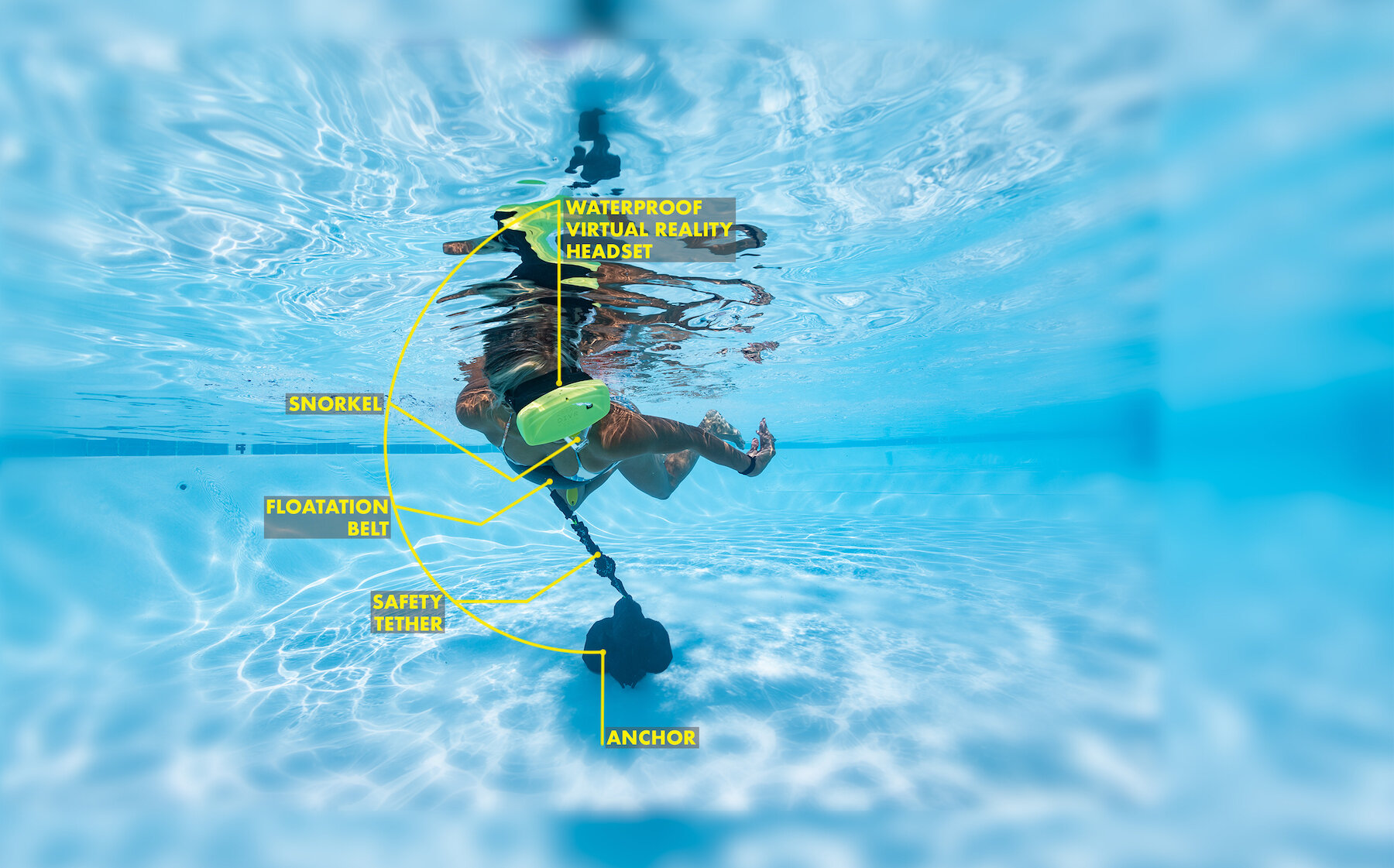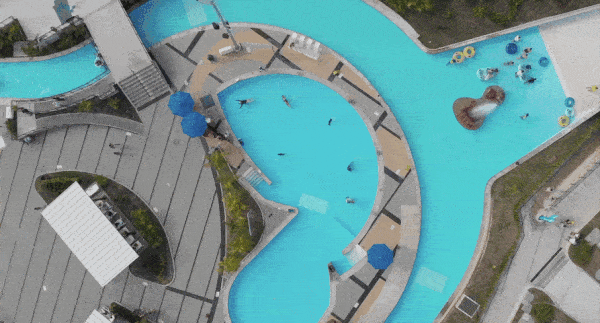
Combining weightlessness and the Mammalian Dive Response to create the most serene, meditative experiences
As co-founder and CTO of Ballast Technologies, I designed, iterated and co-developed DIVR, a system that gave birth to the field of aquatic virtual reality.
Users wear a snorkeling mask with a lightweight VR system built in. While floating in water with VR, a set of psycho-physiological effects come into play, creating magic!
Collaborators:
Atlas Roufas : Led content design, provided invaluable feedback on physcial design, and co-designed software
Stephen Greenwood : Helped with hardware and user experience feedback
Carter McGuyer (Contract Industrial Designer) : Implemented a subset of the CAD designs

“Unlike sex, VR is crazy better when you do it underwater”
“[Ando] believes that they are forming a deep neural connection to the VR nature experience, which could lead to greater empathy for a changing ocean due to climate change.”
The Science Behind the Magic
Double Immersion
We are collaborating with Stanford’s Virtual Human Interaction Lab to study the cognitive and affective effects of the “double immersion” of being in water and virtual reality simultaneously. The core hypothesis is that this double immersion provides increased presence, especially when the virtual environments support the physical effects of weightlessness. For this reason all the content created for the DIVR system is crafted in environments which support this, such as flying, swimming and outer space experiences.
Influencing Mindfulness
We theorize that the Mammalian Dive Reflex combined with enhanced proprioception due to the tactility of the liquid medium creates a calming effect on the mind, and increased connection to the body. We build on these effects with tranquil but stimulating virtual experiences to give users an in-body rather than an out-of-body experience.

How it all began
While studying whale sharks and manta rays in Mozambique in 2013, I had incredible experiences with marine life, and on one particularly extraordinary encounter with a whole pod of singing humpback whales. I surfaced with the intuition that combining water and virtual reality could be profound, and allow non-divers to have such experiences and build a bond with the ocean.
It took me another 4 years to find the right set of co-founders who believed in this vision and together we set out to pull this trick out of the hat.
Early User Testing
A variety of these prototypes were tested in early 2017, including the full face version, the fabric cover to let water permeate and bone conduction headphones playing un-synced background music on bone-conduction headphones. All the development was done with stock content, mostly 360 videos of underwater shots and a CGI spacewalk. These prototypes were shown to the MIT Technology Review and Upload VR
v0 : pre-funding
For most of 2017 we were experimenting, imagining far flung use cases and researching what “felt” good and what would enhance the experience. We had terrible ideas about potential customers and didn’t really have a plan to get to market.
Our initial solutions were very tech heavy : coming from a startup building large scale tracking systems, I was excited by the idea of building an underwater tracking system for VR, and assumed it was absolutely necessary. These designs also imagined a fully submerged, exotic looking system!

First concept render that we used to explain our vision to partners and potential customers

Initial system design ideas that included a Sixense STEM magnetic tracker in a waterproofed housing; very technology-centric

3D printed pieces glued onto a snorkel mask

A very elaborate early design showing a fully submerged system, with breathing apparatus and camera based tracking and a fan to simulate motion by moving water over the user. We had imagined astronaut training type use cases for this

One of the first 3D printed prototypes with a hinged enclosure for a phone glued to a full face snorkel mask, with a very Friday the 13th vibe!

The crux of the patent is the ability to use water as part of the refractive medium in the optical path. This allows water to flood the headset, and not needing to capture air inside, making the headset neutrally buoyant

Lucky to have great advisors who encouraged us to file patents early: images from the first patent filing showing the mask housing design
v1 : for a real customer
We rented a house with a pool and spent 2 months rapid prototyping and working with the principles of human-centered design
After we completed the VRSlide development and were waiting for it to be proven and gain traction, we sold the idea of a VR Snorkeling system to a customer, and used the down-payment to finance the development of the next iteration.
That customer was a group of waterparks, one we had gotten to know intimately while developing the VRSlide, and set about to ship something real.
Major Design Features
Flotation Aid & Tether
It was absolutely essential to make users feel as comfortable as possible, and hit upon the idea of adding a flotation aid to help this aspect.
We tried ankle and arm floats but eventually picked a flotation belt for its ease of use and ergonomics. This allows users to not have to constantly work to stay afloat, enabling relaxation.
Once users put on on the VR headset, they quickly lose track of their surroundings due to the “double-immersion” that VR + water provides. To prevent them from swimming into walls of the pool and others and others around, we experimented with tethering users to the bottom of the pool.
This added the design constraint that the pool
had to be shallower than standing height
, which turned out to be a great safety feature as well.
We started with a rope tied to a rock, and iterated till we got to a sandbag filled with weights attached to an elastic tether.
The amount if elasticity was crucial so that users that chose to swim would have some leeway before being gently pulled back.
Once we were able to combine these two features into a compact unit, it started feeling right.
Visual Aesthetics

Art references for wave designs

Emulating the wake of a ship

Design changes to enable the wireless charger to dock unobtrusively

Various iterations of the dock plate
Wireless Docking System
The software platform and Android modifications created for VRSlide were a natural fit for DIVR, thereby using an Android device inside the modular headset. This allows newer models to be swapped in, as older ones become obsolete.
This design allows the use of wireless chargers so that devices are never taken out of the housing, and need minimal handling, while HQ manages all software remotely over the cloud.
This was motivated by my design ethos that the headset is never treated as a mobile phone, needing interfacing, but rather a standalone VR device that has no touchscreen or 3D interface. I found this ideal for the waterpark/resort environment, where these devices are typically managed by lower level employees or lifeguards. This also removes the temptation of ‘playing around’ with the phones, and limits their functionality to only the VR experiences.

Underwater Sound
Human bodies perceive sound underwater through their bones. I designed the DIVR headset to transmit sound to users via one of two mechanisms:
Bone conduction headphones
Direct transduction through the headset
Due to the proprietary nature of this feature, I am unable to divulge any more details here.

Designed to be dead simple
In and out of any pool in less than 5 mins
Users strapped in and content launch in 2 mins
Designed for efficiency and durability
Built for waterparks, hotels resorts and aquariums
Currently installed at over 25 locations across the United States, Germany, Mexico, Sweden, France, Belgium, Austria, Colombia, Taiwan and the United Arab Emirates.
Even though this system is built for commercial use, we imbue all our experiences with a sense of awe and wonder. The underlying technology inherently connects users to the world they experience.

DIVR+
Haptics and Jets
We partnered with SubSea Systems to add jets and haptic effects,
transforming the relaxing DIVR experience into an exhilarating rollercoaster




Content Design

Atlantis DIVR : Designed for kids, this is a journey to the lost city of Atlantis with a sea lion escaping an oil spill
Ocean DIVR : Our original experience for DIVR, created to lead you through a 'drift dive' starting in a shallow reef, and taking you into the open ocean to swim with singing Humpback whales
Space DIVR : Go on a spacewalk through the ISS, which is not what it seems!

Dragon DIVR+ : Our first exclusive for DIVR+, this is a thrilling experience through the valley of the Dragons. Lots of dives and corkscrews, which only work in aquatic VR; Hang on!

Breathe : Our first meditation experience, designed for use both in and out of water, uses luminescent jellyfish to help you breathe slow and deep, and focus on your breath
For more images and videos, please check out the official Ballast Instagram page
All images and technology are property of Ballast Technologies Inc. Please visit our website to learn more.
#vr #virtualreality #DIVR #ballastvr #empathy #productdesign #hardware #unity #watertherapy #aquaticvr









